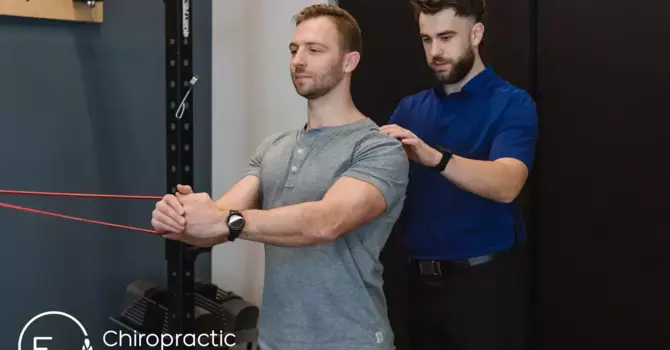
We’ve all been there.
A little twinge in your lower back after a deadlift. Some stiffness in your neck after a long day at the computer. That mild ache in your knee when you’re out for a run. It doesn’t stop you from living your life, so you brush it off. Maybe you pop an Advil or stretch it out and hope it goes away.
But here’s the truth: those “minor” aches are often your body’s early warning signs. And when they’re ignored, they can snowball into bigger, more serious problems that sideline your workouts, impact your sleep, and affect your day-to-day life.
At E3 Chiropractic + Wellness, we work with countless individuals in Saskatoon who wish they had addressed those nagging issues sooner. That’s why we’re here to help you understand why those subtle symptoms matter—and what you can do to prevent them from becoming full-blown injuries.
The Slow Creep of Dysfunction
Pain rarely appears out of nowhere. It often builds up gradually—especially in active individuals—due to repetitive stress, poor movement patterns, or unresolved compensations from previous injuries. You may not notice the dysfunction right away because your body is good at compensating. But eventually, it reaches a tipping point.
What starts as:
- Occasional tightness after workouts
- Discomfort only during certain movements
- Needing to "crack" your neck or back frequently
- Minor swelling or stiffness in a joint
- Can evolve into:
- Tendinitis or bursitis
- Disc herniations or nerve impingements
- Joint instability or arthritis
- Chronic pain or mobility limitations
The earlier you address these symptoms, the faster and easier they are to treat.
Why Do We Ignore the Early Signs?
There are a few common reasons people overlook or dismiss minor aches:
1. “It Doesn’t Hurt That Bad”
Pain is only one measure of injury. You might not feel intense discomfort, but that doesn’t mean your body is functioning properly. In fact, pain is often the last sign that something has been going wrong.
2. “I Can Still Train/Work/Move”
Just because you can still perform your usual activities doesn’t mean you’re doing them well. Compensating with poor form or uneven movement can overload other areas, setting you up for more serious injury.
3. “It Comes and Goes”
Intermittent pain is still pain. And often, recurring pain indicates an underlying issue that needs to be addressed—before it becomes permanent.
The Domino Effect of Compensation
When one part of your body isn't functioning correctly, another part has to pick up the slack. This is known as compensation. For example:
- If your ankle mobility is limited, your knee or hip might work harder during a squat.
- If your thoracic spine is stiff, your neck or lower back may overextend to make up for it.
- If your glutes aren't firing properly, your hamstrings or low back might become overworked.
This domino effect is often what turns small problems into large ones. And it’s why a thorough assessment is critical. At E3 Chiropractic + Wellness, our Saskatoon Chiropractor team doesn’t just treat the site of pain—we identify the root cause and correct it at the source.
The Power of Early Intervention
Here’s what happens when you take minor aches seriously and act early:
Faster Recovery: Small imbalances and restrictions respond well to conservative care like chiropractic adjustments, rehab exercises, and mobility work.
Less Downtime: You can continue training and staying active with fewer modifications or time off.
Lower Risk of Re-injury: Addressing the underlying issue helps create better movement patterns that are more resilient long term.
Cost-Effective Care: Treating a small issue now is less expensive than dealing with imaging, medications, or surgery later.
Common “Minor” Aches That Deserve Attention
These symptoms may seem minor now, but they often signal deeper issues:
Low Back Tightness
- Often caused by poor lifting mechanics, weak core stabilization, or prolonged sitting. If untreated, it may develop into disc irritation or chronic back pain.
Shoulder Pinching or Clicking
- Common in bench pressers and overhead athletes. May be early signs of rotator cuff irritation, scapular dyskinesis, or labral involvement.
Neck or Upper Back Stiffness
- Often tied to forward head posture, screen time, and poor thoracic mobility. Can lead to tension headaches, nerve irritation, or chronic neck pain.
Knee Twinges with Running
- Could stem from IT band tightness, quad dominance, or glute weakness. Ignoring it can lead to patellar tracking issues, tendinitis, or stress fractures.
Foot or Heel Discomfort
- Might be the beginning of plantar fasciitis, collapsed arches, or Achilles issues. If left unaddressed, it can drastically affect your gait and load mechanics.
What Can You Do About It?
Whether you’re a CrossFitter, runner, weekend warrior, or just trying to stay active and pain-free, here’s how to get ahead of these issues:
1. Get Assessed
- A functional movement assessment can help identify restrictions, weaknesses, or imbalances before they lead to pain. Our team at E3 Chiropractic + Wellness uses the E3 Approach:
- Evaluate what’s wrong and why
- Eliminate the pain through hands-on treatment
- Empower you with strength, mobility, and movement strategies
2. Listen to Your Body
- Pay attention to any recurring stiffness, discomfort, or mobility issues. These symptoms are your body’s way of asking for help.
3. Move Well and Often
- Incorporate regular mobility work, strength training, and recovery strategies. Move with intention—not just intensity.
4. Seek Professional Help Early
- Even one session with a skilled Saskatoon Chiropractor can uncover patterns that may otherwise go unnoticed. The earlier you intervene, the more options you have for conservative treatment.
The Bottom Line
Ignoring minor aches may seem harmless now—but over time, those little warning signs can snowball into bigger, more complex injuries. The good news? It doesn’t have to be that way.
With expert assessment, proactive care, and a personalized plan, you can stay ahead of the pain and keep doing what you love—stronger, longer, and injury-free.
At E3 Chiropractic + Wellness, our mission is to help you move better, feel better, and live better. Whether you’re just starting to notice a nagging pain or you want to prevent future issues altogether, we’re here to guide you every step of the way.
Don’t wait for the pain to get worse—Click HERE to book your consultation today with a Saskatoon Chiropractor who puts your long-term health first.





